Christianity in Turkey
| Christianity by country |
|---|
 |
|
|
Religion in Turkey  |
|---|
| Secularism in Turkey |
| Irreligion in Turkey |
Christianity in Turkey has a long history, dating back to the
This was due to events which had a significant impact on the country's demographic structure, such as the
In 2011 according to the
In 2020 the
Historical background
Early Christianity


The
The
The historical
The Eastern Orthodox Church split from Rome during the
Two out of the five centers (
Turkey is also home to the
The death of the
Ottoman Empire


In accordance with the traditional custom of the time, the
Throughout the period of the
The women of Constantinople also suffered from rape and sexual violence at the hands of Ottoman forces.[69] According to historian Barbaro, "all through the day the Turks made a great slaughter of Christians through the city". According to historian Philip Mansel, widespread persecution of the city's civilian inhabitants took place, resulting in thousands of murders and rapes, and 30,000 civilians being enslaved or forcibly deported.[70][71][72][73] George Sphrantzes says that people of both sexes were raped inside the church of Hagia Sophia.

The first
In the 1890s the
First World War
During the tumultuous period of the
Kurdish-dominated Hamidiye slaughtered Christian Armenians in Tur Abdin region in 1915.
Treaty of Lausanne
The Greek forces who
Republic of Turkey (1923–present)
The
The
In the pre-war period, Protestant Christian missionaries from North America had been actively involved in the Ottoman education system. Many of the schools were closed down and suffered under stringent regulations and burdensome taxes during the secularization of Turkey. Historically, these schools had worked with the Christian communities in the Ottoman Empire, and were regarded with suspicion by the fledgling republic.[91]
In 2001, Turkey's National Security Council (MGK) reported that it considers Protestant Christian missionaries the third largest threat to Turkey's national security, surpassed only by Islamic fundamentalism and the Kurdish separatist organization Kurdistan Workers' Party (PKK). A 2004 report by the Turkish Armed Forces (TAF) similarly recommended implementing new laws to curb Christian missionary activities in the country. According to the Turkish Evangelical Churches movement, Turkish Protestant churches had only 3,000 members in 2009—about half of these were former Muslim converts to Christianity, while the others were Christian converts from Armenian Orthodox and Syriac Christian churches.[92] Since Turkish nationality was often perceived exclusively as a Muslim identity after the Balkan Wars, the influence of Protestant Christian missionaries on Turkey's Alevi population has been a concern since the era of Committee of Union and Progress rule.[92][93] In 2016, the Association of Protestant Churches in Turkey released a report warning of an increase in anti-Christian hate speech.[94]
Historically, the Christian population of Turkey has been largely peaceful and non-disruptive, with the notable exception of one former Muslim convert to Christianity who hijacked the Turkish Airlines Flight 1476 in 2006 with the stated intent of flying it to the Vatican to meet the Pope and ask for his help to avoid serving in the Turkish Armed Forces, which he referred to as a "Muslim army".[95]
In 2013, the
Today, the Christian population of Turkey is estimated at 203,500–370,000 Christians.
Since the
Christian communities

The largest Christian population in Turkey is located in
The
By the 21st century, Greek Orthodox Christians in Turkey had declined to only around 2,000–3,000.[88] There are between 40,000 and 70,000 Armenian Orthodox Christians in Turkey.[3] By some estimates, in the early 2000s there were between 10,000 and 20,000 Catholics and Protestants in Turkey.[114] Since the 1960s, a growing number of Turkish former Muslims are converting to Christianity;[23] estimates range from 4,000 to 35,000 by various sources.[23][115][116][117]
Churches in Turkey
Armenian Apostolic Church
The
There are 35 churches maintained by the religious foundation in Istanbul and its surrounding areas. Besides Surp Asdvadzadzin Patriarchal Church (translation: the Holy Mother-of-God Armenian Patriarchal Church) in Kumkapi, Istanbul, there are tens of Armenian Apostolic churches. There are other churches in
- Armenian Catholic Church - There are several Armenian Catholic churches in Istanbul, including a large cemetery. In Mardin one remains as a Museum and occasional religious center.
- Armenian Evangelical Church - The Armenian Protestants have three churches in Istanbul from the 19th century.[120]
Autocephalous Turkish Orthodox Patriarchate

The
The start of the Patriarchate can be traced to the
In 1924, Karahisarithis started to conduct the
Greek Orthodox Church


During the 8th and 9th centuries, Byzantium was embroiled in the
The
The threeRoman Catholic Church
The
- Latin rite:
- Co-Cathedral of St. Anthony of Padua, Mersin. Jurisdiction: Immediately subjected to the Holy See
- Roman Catholic Archdiocese of İzmir, with seat in the St. John's Cathedral, İzmir.
- Armenian rite: Holy Mother of God Armenian Cathedral Church, Istanbul. Jurisdiction: Immediately subjected to the Holy See.
- Byzantine Rite: Greek Catholic Apostolic Exarchate of Istanbul. Cathedral: Holy Trinity Greek Catholic Cathedral, Istanbul (Ayatriada Rum Katoliki Kilise). Jurisdiction: Immediately subjected to the Holy See.
- Syriac Rite: Syrian Catholic Patriarchal Exarchate of Turkey, with seat in Istanbul. Jurisdiction: Subject to the Syriac Catholic Church.
- Chaldaean Rite: Chaldean Catholic Archdiocese of Diarbekir. Cathedral: St. Mary's Cathedral, Diyarbakır, but with seat in Beyoğlu, Istanbul. Jurisdiction: Chaldean Catholic Church.
Syriac Orthodox Church

The
In modern times, Syriac Orthodox Church hase these provinces in Turkey:[137]
- Patriarchal Vicariate of Filüksinos Yusuf Çetin.
- Patriarchal Vicariate of Mardin under the spiritual guidance and direction of Archbishop Filüksinos Saliba Özmen.
- Patriarchal Vicariate of Turabdinunder the spiritual guidance and direction of Archbishop Timotheus Samuel Aktaş.
- Archbishopric of Adıyaman under the spiritual guidance and direction of Archbishop Gregorius Melki Ürek.
Church of the East
Historical
Protestant churches
Armenian Protestants own 3 churches in Istanbul since the 19th century.[139] There is an Alliance of Protestant Churches in Turkey.[140] There are Protestant churches for foreigners in compounds and resorts, although they are not counted in lists of churches as they are used only by tourists and expatriates.
Church of England

Evangelical churches
The
The Church of Jesus Christ of Latter-day Saints
Recognizing that present-day
List of church buildings in Turkey
Churches of the Armenian rite
| Church name | Picture | Status |
|---|---|---|
| Church of the Apparition of the Holy Cross (Kuruçeşme, Istanbul) Yerevman Surp Haç Ermeni Kilisesi |
active | |
| Holy Archangels Armenian Church (Balat, Istanbul) Surp Hıreşdagabed Ermeni Kilisesi |
active | |
| Holy Cross Armenian Church (Kartal, Istanbul) Surp Nişan Ermeni Kilisesi |
active | |
| Holy Cross Armenian Church (Üskudar, Istanbul) Surp Haç Ermeni Kilisesi |
active | |
| Holy Hripsimiants Virgins Armenian Church (Büyükdere, Istanbul) Surp Hripsimyants Ermeni Kilisesi |
active | |
| Holy Mother-of-God Armenian Apostolic Church (Bakırköy, Istanbul) Surp Asdvadzadzin Ermeni Kilisesi |
active | |
| Holy Mother-of-God Armenian Church (Beşiktaş, Istanbul) Surp Asdvadzadzin Ermeni Kilisesi |
active | |
| Holy Mother-of-God Armenian Church (Eyüp, Istanbul) Surp Asdvadzadzin Ermeni Kilisesi |
active | |
| Holy Mother-of-God Armenian Church (Ortaköy, Istanbul) Surp Asdvadzadzin Ermeni Kilisesi |
active | |
| Holy Mother-of-God Armenian Church (Yeniköy, Istanbul) Surp Asdvadzadzin Ermeni Kilisesi |
active | |
| Holy Resurrection Armenian Church (Kumkapı, Istanbul) Surp Harutyun Ermeni Kilisesi |
active | |
| Holy Resurrection Armenian Church (Taksim, Istanbul) Surp Harutyun Ermeni Kilisesi |
active | |
| Holy Three Youths Armenian Church (Boyacıköy, Istanbul) Surp Yerits Mangants Ermeni Kilisesi |
active | |
| Holy Trinity Armenian Church (Galatasaray, Istanbul) Surp Yerrortutyun Ermeni Kilisesi |
active | |
| Narlıkapı Armenian Apostolic Church (Narlıkapı, Istanbul) Surp Hovhannes Ermeni Kilisesi |
active | |
| St. Elijah The Prophet Armenian Church (Eyüp, Istanbul) Surp Yeğya Ermeni Kilisesi |
active | |
| St. Garabed Armenian Church (Üsküdar, Istanbul) Surp Garabet Ermeni Kilisesi |
active | |
| St. John The Evangelist Armenian Church (Gedikpaşa, Istanbul) Surp Hovhannes Ermeni Kilisesi |
active | |
| St. Gregory The Enlightener Armenian Church (Galata, Istanbul) | active | |
| St. Gregory The Enlightener Armenian Church (Kuzguncuk, Istanbul) Surp Krikor Lusaroviç Ermeni Kilisesi |
active | |
| St. Gregory The Enlightener Armenian Church (Karaköy, Istanbul) Surp Krikor Lusavoriç Ermeni Kilisesi |
active | |
| St. Gregory The Enlightener Armenian Church (Kınalıada, Istanbul) Surp Krikor Lusavoriç Ermeni Kilisesi |
active | |
| St. James Armenian Church ( Altımermer, Istanbul )Surp Hagop Ermeni Kilisesi |
active | |
| St. Nicholas Armenian Church (Beykoz, Istanbul) Surp Nigoğayos Ermeni Kilisesi |
active | |
| St. Nicholas Armenian Church (Topkapı, Istanbul) Surp Nigoğayos Ermeni Kilisesi |
active | |
| St. Santoukht Armenian Church (Rumelihisarı, Istanbul) Surp Santuht Ermeni Kilisesi |
active | |
| St. Saviour Armenian Chapel (Yedikule, Istanbul) Surp Pırgiç Ermeni Kilisesi |
active | |
| St. Sergius Armenian Chapel (Balıklı, Istanbul) Surp Sarkis Anıt Mezar Şapeli |
active | |
| St. Stephen Armenian Church (Karaköy, Istanbul) Surp Istepanos Ermeni Kilisesi |
active | |
| St. Stephen Armenian Church (Yeşilköy, Istanbul) Surp Istepanos Ermeni Kilisesi |
active | |
| St. Takavor Armenian Apostolic Church (Kadıkoy, Istanbul) Surp Takavor Ermeni Kilisesi |
active | |
| Saints Thaddeus and Barholomew Armenian Church (Yenikapı, Istanbul) Surp Tateos Partoğomeos Ermeni Kilisesi |
active | |
| St. Vartanants Armenian Church (Feriköy, Istanbul) Surp Vartanants Ermeni Kilisesi |
active | |
| The Twelve Holy Apostles Armenian Church (Kandilli, Istanbul) Surp Yergodasan Arakelots Ermeni Kilisesi |
active | |
| Holy Forty Martyrs of Sebastea Armenian Church (Iskenderun, Hatay) Surp Karasun Manuk Ermeni Kilisesi |
active | |
| St. George Armenian Church (Derik, Mardin) Surp Kevork Ermeni Kilisesi |
active | |
| St. Gregory The Enlightener Armenian Church (Kayseri) Surp Krikor Lusavoriç Ermeni Kilisesi |
active | |
| St. Gregory The Enligtener Armenian Church (Kırıkhan, Hatay) Surp Krikor Lusavoriç Kilisesi |
active | |
| Church of St. George of Samatya (Samatya, Istanbul) Surp Kevork Kilisesi |
active | |
St. Giragos Armenian Church (Diyarbakır) Surp Giragos Ermeni Kilisesi |
 |
active |
Vakıflı Church Vakıflıköy Ermeni Kilisesi |
 |
active |
| Cathedral of Kars |  |
converted into a mosque |
| Narekavank |  |
destroyed, mosque built on the site |
| Cathedral of Ani |  |
UNESCO World Heritage Site |
| Virgin Mary Church, Kayseri | 
|
museum (converted into a library) |
| St. John the Baptist Armenian Church (Uskudar) | unknown | |
| Ktuts monastery |  |
abandoned |
| Cathedral of Mren |  |
ruins |
Holy Apostles Monastery |
 |
ruins |
| Horomos |  |
ruins |
| Karmravank (Vaspurakan) | 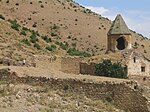 |
ruins |
| Kaymaklı Monastery | ruins | |
| Khtzkonk Monastery | ruins | |
| Varagavank |  |
ruins |
| Saint Bartholomew Monastery | 
|
ruins |
St. Marineh Church, Mush |
ruins | |
Saint Karapet Monastery |

|
destroyed, village built on the site |
| St. Stepanos Church | 
|
destroyed |
Tekor Basilica |
 |
destroyed |
| Vank Church in Şenkaya | destroyed by treasure hunters in 2021[145] |
Churches of the Byzantine and Greek Orthodox rite
| Church name | Picture | Status |
|---|---|---|
Church of St. George, Istanbul |
 |
active |
Church of St. Mary of Blachernae (Istanbul) |
 |
active |
Church of St. Mary of the Mongols |
 |
active |
| İskenderun St. Nicholas Church[146] | 
|
damaged due to 2023 Turkey–Syria earthquake
|
| Mersin Orthodox Church | 
|
active |
| Church of St. Kyriaki, Istanbul | 
|
active |
Meryem Ana Church |
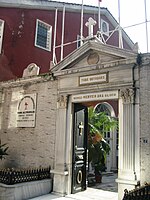 |
active |
| Bulgarian St. Stephen Church |  |
active |
| St. Demetrius Church in Feriköy, Istanbul | 
|
active |

|
active | |
| Panayia Evangelistria in Beyoğlu, Istanbul | 
|
active. Built in 1893.[147] |
| Saint Andrew in Krisei | 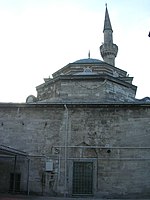 |
converted into a mosque |
Chora Church |
 |
converted into a mosque |
| Church of Christ Pantokrator (Constantinople) |  |
converted into the Zeyrek Mosque |
| Church of Christ Pantepoptes (Constantinople) | 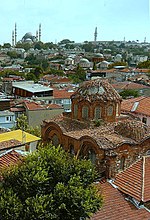 |
converted into a mosque |
| Monastery of Gastria |  |
converted into a mosque |
| Hagia Sophia |  |
converted into a mosque |
| Church of the Holy Apostles | demolished, Fatih Mosque built on top
| |
| Church of Saint John the Baptist at Lips (Constantinople) |  |
converted into a mosque |
| Monastery of Stoudios |  |
to be converted into a mosque |
| Church of Saint John the Baptist en to Trullo (Constantinople) | 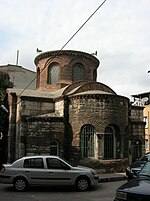 |
converted into a mosque |
| Myrelaion |  |
converted into a mosque |
| Church of Saint Nicholas of the Caffariotes (Istanbul) |  |
converted into a mosque |
| Pammakaristos Church |  |
converted into a mosque |
| Church of Sergius and Bacchus |  |
converted into a mosque |
| Saint Irene church |  |
converted into a mosque |
| Church of Vefa |  |
converted into a mosque |
| Holy Martyrs Menodora, Metrodora, and Nymphodora |  |
converted into a mosque |
| Saint Mary of Constantinople |  |
converted into a mosque |
| Church of Hagia Thekla tu Palatiu ton Blakhernon |  |
converted into a mosque |
Church of Hagios Theodoros (Constantinople) |
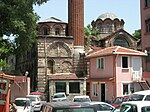 |
converted into a mosque |
| Church of Hagias Theodosias en tois Dexiokratus |  |
converted into a mosque |
| Church of Saint Thomas |  |
converted into a mosque |
| Church of the Theotokos Kyriotissa (Constantinople) |  |
converted into a mosque |
| Nakip Mosque | converted into a mosque | |
| Hagios Eugenios Church | 
|
converted into a mosque |
| Panagia Chrysokephalos Church | 
|
converted into a mosque |
| Virgin Mary Church | 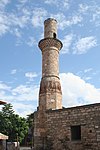
|
converted into a mosque |
| Hagia Sophia, Trabzon | 
|
converted into a mosque |
| Hagia Sophia, İznik | 
|
converted into a mosque |
| Church of Christ and Saint Stephen | 
|
converted into a mosque |
| Toklu Dede Mosque | converted into a mosque (before was a church of unknown dedication) | |
| Alâeddin Mosque | 
|
converted into a mosque (before was a basilica of unknown dedication) |
| Saint Paul Cathedral | 
|
converted into a mosque |
| Aya Panagia Greek Church (Yaman Dede Mosque), Talas, Kayseri | 
|
converted into a mosque |
| St. Gregory of Nazianzos Church, (Kilise Camii), Güzelyurt, Aksaray. | 
|
converted into a mosque |
| Hagia Irene | 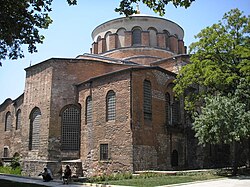
|
museum |
Sümela Monastery
|

|
museum |
| Virgin Mary Monastery | museum | |
| House of the Virgin Mary | 
|
museum |
| Church of St Nicholas of Myra(Santa Claus) (Demre) | 
|
ruins, museum |
| Taşbaşı Church, Ordu province | 
|
museum |
| Saint John's Church, Gülşehir | museum | |
| Saint Michael Church in Akçaabat | now used for social and cultural activities and museum by the Turkish Ministry of Culture and Tourism, built in 1332[148] | |
| Saint Voukolos Church | 
|
now used for social and cultural activities |
| Kuruköprü Monumental Church | 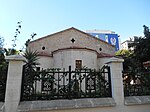
|
museum |
| Saint Paul's Church, Tarsus | 
|
museum |
| Ayazma Church (Faneromeni Church) in Ayvalık | After Greeks left in 1925 due to the Population exchange between Greece and Turkey, it turned into an olive oil factory, for a period, and because of that the interior of the building changed. There are plans to be turned into a museum. | |
| Church of St. Polyeuctus | 
|
archaeological site |
| Church of St. Jean at Ayasuluk Hill | archaeological site. The current building dates back to the Emperor Justinian I, but there was a church building even before that.[149]
| |
| Church of the Apostles at Anazarbus | archaeological site.[150] | |
| Churches of Göreme | archaeological sites. In Göreme at Cappadocia there are a lot of old Greek churches. | |
| Basilica of St. John | 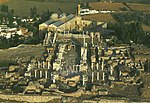
|
archaeological site |
| Çanlı Kilise | 
|
archaeological site |
Cave monastery of İnceğiz
|

|
archaeological site |
| Gümüşler Monastery | 
|
archaeological site |
| Eskigümüş Monastery | archaeological site | |
| 35 churches and chapels in caves at the Ayazini | archaeological site[151] | |
| Church on the Küçük Tavşan Adası | archaeological site. A church of the 6th century.[152][153] | |
| Selime Cathedral at the Ihlara Valley in Cappadocia
|

|
archaeological site[154] |
| Virgin Mary Church at the Ihlara Valley in Cappadocia
|
archaeological site[155] | |
| Chapel at Bağcılar | archaeological site. In 2023, a Greek chapel has been discovered at Bağcılar in Istanbul.[156] | |
| Underwater basilica in Iznik Lake
|
archaeological site. It was built sometime after 390 AD and destroyed in a big earthquake in 1065.[157] | |
| Saint George Church at Diyarbakır | built around 200 AD, now an art gallery[158] | |
| Bodrum Aya Nikola Church[TR] | 
|
museum |
| Saint Analipsis Church (Yüksek Kilise), Aksaray | 
|
museum |
| Niğde Prodromos Church | 
|
museum |
| St. Theodore Church (Üzümlü Kilise), Derinkuyu | 
|
museum |
| Panagia Theoskepastos Monastery, Trabzon | 
|
archaeological site. |
| Saint Anne Church, Trabzon | 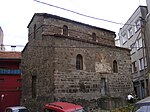
|
museum |
| Jason Church | 
|
museum |
| Vazelon Monastery | 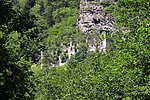
|
archaeological site. |
| Meryem Ana Monastery | archaeological site. | |
| Sinope Koimesis Church | 
|
archaeological site. |
| Çakırkaya Monastery, Gümüşhane[159] | museum.[160] | |
| Üzümlü Church | museum. | |
Church within Kaymakli/Anakou Underground City
|
museum. | |
| Hagia Triada Church, Ayvalık | ongoing restoration. | |
| Church of St. John, Tirilye | transferred to private property after the Greek population was expelled in 1923 and now is a residence | |
| St. Basil's Church, Tirilye | became a Stone School (being used for the workshops for carpentry and iron works) and the "Dündar House" (used as a mess house) | |
| Palace of Antiochos | a hotel is on top of the ruins but some traces of the palace can be seen under a glass floor at the dining hall. | |
| Niğde Küçükköy Church | 
|
abandoned |
| Church of the Virgin of the Pharos | ruins | |
| Kuştul Monastery | 
|
ruins |
| Göreği Monastery, Fatsa district | ruins | |
| Pavrezi Chapel, Gümüşhane[159] | ruins | |
| Hagios Georgios Monastery, Gümüşhane[159] | ruins | |
| Panagia Monastery, Gümüşhane[159] | ruins | |
| Seven or more ruined churches in Santa[161] | ruins | |
| Kamışlı Kilisesi/Çakrak Church, Alucra district | ruins | |
| Üçayak Byzantine Church | 
|
ruins |
| Hasanaliler Church | 
|
ruins |
| Hodegon Monastery | ruins | |
| Pelekete monastery | ruins | |
| Medikion monastery | ruins | |
| Batheos Rhyakos Monastery | ruins, some buildings are used as animal shelters | |
| Kaman Demirli Church (Kilise Kalıntıları), Kaman | 
|
ruins of unknown dedication. |
| Saint Demetrius Monastery on Cunda Island | ruins, built in 1766 destroyed by treasure hunters in 2020[162] | |
| Saint Georgios Church in Nilüfer, Bursa | ruins, built in 1896 and fell down in 2020, because it was neglected[163] | |
| Hutura Hagios Monastery Church in Gümüşhane | ruins, built in the 14th century, it is often plundered by treasure hunters. The library of the monastery is also destroyed.[164] | |
| St. Yuannis Church (Aziz Yuannis Kilisesi) or St. John the Russian Church, Ürgüp | ruins | |
| St. Spyridon Church (Kizil Kilise), Güzelyurt. | 
|
ruins |
| Saint Gregory of Nyssa Church, Trabzon | 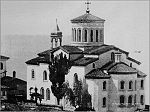
|
destroyed |
| Heliou Bomon monastery | destroyed |
Catholic churches
| Church name | Picture | Status |
|---|---|---|
| Church of Santa Maria, Trabzon | active | |
| Virgin Mary Latin Catholic Church (Tubini Şapeli), Kadıköy | active | |
| Cathedral of the Holy Spirit, Istanbul |  |
active |
St. Anthony of Padua Church in Istanbul |
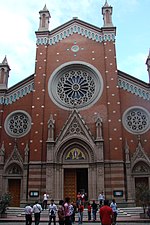 |
active |
| Cathedral of the Annunciation, İskenderun |  |
damaged due to 2023 Turkey–Syria earthquake
|
Church of St. Anthony, Mersin |
 |
active |
| St. John's Cathedral, İzmir |  |
active |
| Church of SS Peter and Paul, Istanbul |  |
active |
| Church of Saint Benoit, Istanbul | 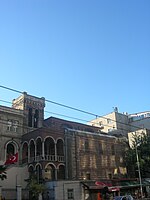
|
active |
| Church of St. Mary Draperis, Istanbul | 
|
active |
| Saint Paul Church, Adana | 
|
active |
| St. Mary's Church, İzmir | 
|
active |
St. Térèse Church , Ankara
|

|
active |
| St. George's Catholic Church | 
|
active[165] |
| Notre-Dame de L'Assomption, İstanbul | 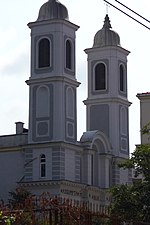
|
active |
Church of San Domenico (Constantinople) |
 |
converted into a mosque |
Church of St Peter |
 |
museum |
Churches of the Georgian rite

| Church name | Picture | Status |
|---|---|---|
| Our Lady of Lourdes Church, Istanbul (Bomonti Gürcü Katolik Kilisesi) |  |
active |
| Khakhuli Monastery (Haho/Bağbaşı) |  |
converted into a mosque |
| Doliskana (Dolishane/Hamamlıköy) |  |
converted into a mosque |
| Ishkhani (İşhan) | 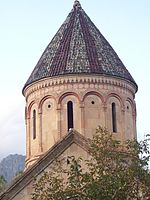 |
protected
(since 1987)[167] |
| Parkhali (Barhal/Altıparmak) | 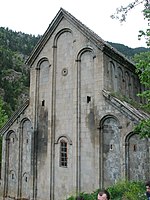 |
protected[168] |
| Oshki (Öşki Manastırı/Öşk Vank/Çamlıyamaç) |  |
protected |
Otkhta Eklesia (Dörtkilise) |
 |
abandoned |
| Khandzta | 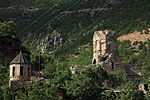 |
ruins |
| Ekeki |  |
ruins |
| Parekhi | 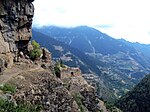 |
ruins |
| Makriali St. George church, Kemalpaşa, Artvin |  |
ruins |
St. Barlaam Monastery (Barlaham Manastırı), Yayladağı |
ruins | |
| Ancha monastery |  |
ruins |
| Okhvame, Ardeşen |  |
ruins |
| Tskarostavi monastery |  |
ruins |
| Bana cathedral (Penek) |  |
ruins |
Tbeti Monastery (Cevizli) |
 |
ruins |
| old Georgian Church, Ani |  |
ruins |
| Opiza |  |
ruins |
Protestant churches
Anglican churches
| Church name | Picture | Status |
|---|---|---|
| Christ Church, Istanbul | 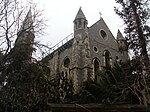 |
active |
| St. John the Evangelist's Anglican Church, İzmir |  |
active |
Other churches
| Church name | Picture | Status |
|---|---|---|
| Buca Protestant Baptist Church[TR] | 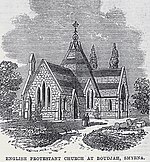 |
active |
| Kreuzkirche, İstanbul[DE] |  |
active |
| Samsun Protestant Church | 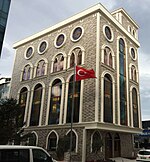 |
active |
| Church of the Resurrection, İzmir |  |
active |
| All Saints' Church, Moda |  |
active |
Churches of the Syriac rite
| Church name | Picture | Status |
|---|---|---|
| Mor Sharbel Syriac Orthodox church in Midyat |  |
active |
| Mor Gabriel Monastery |  |
active |
| Mor Ephrem Syriac Orthodox Church, Yeşilköy, Istanbul |  |
active[169] |
| Mor Hananyo Monastery |  |
active |
| Mor Yuhanna Monastery in Eğil | museum[170] | |
| Zuqnin Monastery |
List of settlements
Significant Christian population
- Balat, Fatih
- Fener, Fatih
- Moda, Kadıköy
Majority Christian population
Majority Christian population
- Anıtlı, Midyat
- Beth Kustan, Midyat
- Elbeğendi, Midyat
- Gülgöze, Midyat
- Taşköy, Nusaybin
- Üçköy, Nusaybin
- Üçyol, Nusaybin
- Dağiçi, Nusaybin
- Bülbül, Yeşilli
- Dereiçi, Savur
- Çatalçam, Dargeçit
Significant Christian population
- Altıntaş, Midyat
- Bardakçı, Midyat
- Barıştepe, Midyat
- Budaklı, Midyat
- Doğançay
- Güngören, Midyat
- İzbırak, Midyat
- Narlı, Midyat
- Mercimekli, Midyat
- Ortaca, Midyat
- Yemişli, Midyat
- Dibek, Nusaybin
- Odabaşı, Nusaybin
- Girmeli, Nusaybin
- Günyurdu, Nusaybin
Majority Christian population
See also
- Catholic Church in Turkey
- Christianity and Islam
- Christianity in Cyprus
- Christianity in the Ottoman Empire
- Eastern Orthodoxy in Turkey
- Freedom of religion in Turkey
- Human rights in the Middle East
- Human rights in Muslim-majority countries#Turkey
- Human rights in Turkey#Freedom of religion
- Irreligion in Turkey
- Islam and other religions
- Islam in Turkey
- Karamanlides, a Turkish-speaking Greek Orthodox community
- Nestorian rebellion
- Persecution of Christians in the Muslim world
- Protestantism in Turkey
- Religion in the Middle East
- Religion in Turkey
- Religious minorities in Turkey
- Secularism in Turkey
- Xenophobia and discrimination in Turkey
- Xenophobia and racism in the Middle East
References
- ^ a b "Religious Composition by Country, 2010-2050". December 21, 2022.
- ^ a b "The Global Religious Landscape". Archived from the original on September 28, 2018.
- ^ LCCN 2016961241.
- ^ from the original on June 26, 2019.
- ^ a b "The Global Religious Landscape". ResearchGate. Archived from the original on April 2, 2020. Retrieved February 8, 2019.
- ^ "National Profiles | World Religion". www.thearda.com. Retrieved August 23, 2024.
- ^ "Türkiye'de Hristiyan nüfusu ve kilise sayısı - Demokrat Gündem - Haberler - Son Dakika Haberleri". demokratgundem.com (in Turkish). June 19, 2023. Retrieved August 23, 2024.
- ^ https://cdn.teyit.org/wp-content/uploads/2019/11/nufustahriri.pdf
- ^ "Türkiye farklı inançlara sağlanan ibadet yeri sayısında Batı'nın 5 kat önünde". www.aa.com.tr. Retrieved August 23, 2024.
- ^ U.S. Department of State. 2023. Archivedfrom the original on January 18, 2025. Retrieved January 21, 2025.
- ^ from the original on August 30, 2024. Retrieved August 30, 2024.
- ^ a b c d e Morris, Benny; Ze'evi, Dror (November 4, 2021). "Then Came the Chance the Turks Have Been Waiting For: To Get Rid of Christians Once and for All". Haaretz. Tel Aviv. Archived from the original on November 4, 2021. Retrieved November 5, 2021.
- ^ ISBN 978-0-674-24008-7.
- ^ S2CID 201424062.
- ^ S2CID 154145301.
- ^ ISBN 9780191750304. Archivedfrom the original on January 15, 2023. Retrieved January 2, 2023.
- ^ S2CID 71551858.
- ^ S2CID 143541451. Archived from the original on March 25, 2020. Retrieved August 2, 2020 – via Academia.edu.
- ^ [3][4][11][12][13][14][15][16][17][18]
- ^ [3][4][11][12][13][14][15][16][17][18]
- ^ Chapter: The refugees question in Greece (1821–1930) in "Θέματα Νεοελληνικής Ιστορίας", ΟΕΔΒ ("Topics from Modern Greek History"). 8th edition (PDF), Nikolaos Andriotis, 2008
- ^ Quarterly, Middle East (2001). "Editors' Introduction: Why a Special Issue?: Disappearing Christians of the Middle East" (PDF). Middle East Quarterly. Archived from the original on May 11, 2013. Retrieved June 11, 2013.
- ^ a b c d "Fearing a new holy empire: Just when Turks are worried about Christians, here comes the Pope". Maclean's. December 4, 2006. Archived from the original on July 19, 2021. Retrieved May 25, 2022.
More tangibly, figures published in January 2004 in Turkey's mainstream Milliyet newspaper claimed that 35,000 Muslims, the vast majority of them in Istanbul, had converted to Christianity in 2003. While impossible to confirm (the Turkish government does not release these figures), the rate of conversion, according to Christian leaders in Turkey, is on the rise.
- ^ a b c "Turkish Protestants still face "long path" to religious freedom". christiancentury.org. Archived from the original on October 17, 2014. Retrieved November 3, 2014.
- ^ "Christian persecution – Turkey". www.opendoorsusa.org. 2015. Archived from the original on April 7, 2015. Retrieved January 28, 2021.
- from the original on September 28, 2024. Retrieved January 15, 2025.
- ^ [3][4][11][12][13][14][15][16][17][18]
- ^ [3][4][11][12][13][14][15][16][17][18]
- ^ Chapter The refugees question in Greece (1821–1930) in "Θέματα Νεοελληνικής Ιστορίας", ΟΕΔΒ ("Topics from Modern Greek History"). 8th edition (PDF). Nikolaos Andriotis. 2008.
- ^ "'Editors' Introduction: Why a Special Issue?: Disappearing Christians of the Middle East". Middle East Quarterly. 2001. Archived from the original on May 11, 2013. Retrieved June 11, 2013.
- ^ Turkey's compliance with its obligations yale.edu
- ^ Situation of regional or minority languages in Europe coe.int
- ^ "Global Christianity - A Report on the Size and Distribution of the World's Christian Population" (PDF). Pew Research Center. Archived (PDF) from the original on February 1, 2021. Retrieved June 2, 2022.
- ^ a b c "Foreign Ministry: 89,000 minorities live in Turkey". Today's Zaman. December 15, 2008. Archived from the original on May 20, 2011. Retrieved May 16, 2011.
- ^ "Türkiye'de ortaya çıkan Rum Ortodoks Kilisesi kim veya nedir?". Archived from the original on November 9, 2021. Retrieved January 2, 2023.
- ^ "Türkiye'nin din haritası çizildi". October 28, 2009. Archived from the original on January 2, 2023. Retrieved January 2, 2023.
- ^ "Statistics by Country". www.catholic-hierarchy.org. Archived from the original on December 18, 2016. Retrieved February 18, 2015.
- ^ "Christen in der islamischen Welt – Aus Politik und Zeitgeschichte" (PDF). 2008. Archived from the original on May 2, 2014. Retrieved June 11, 2013.
- ^ "2021 Country and Territory Reports". JW.ORG. 2021. Archived from the original on December 30, 2021. Retrieved November 4, 2022.
- ^ "Statistics and Church Facts | Total Church Membership". newsroom.churchofjesuschrist.org. Archived from the original on June 28, 2019. Retrieved August 24, 2021.
- ^ a b "International Institute for Religious Freedom: Single Post". Iirf.eu. Archived from the original on July 8, 2015. Retrieved August 11, 2015.
- ^ a b Johnstone, Patrick; Miller, Duane Alexander (2015). "Believers in Christ from a Muslim Background: A Global Census". Interdisciplinary Journal of Research on Religion. 11: 17. Archived from the original on November 26, 2015. Retrieved October 20, 2015.
- ^ "Life, Culture, Religion". Official Tourism Portal of Turkey. April 15, 2009. Archived from the original on April 15, 2009. Retrieved February 9, 2013.
- ISBN 978-0-8028-6717-9. Archivedfrom the original on January 15, 2023. Retrieved July 24, 2018.
Constantinople has been the seat of an archiepiscopal see since the fourth century; its ruling hierarch has had the title of"Ecumenical Patriarch" ...
- ISBN 978-90-04-11695-5. Archivedfrom the original on January 15, 2023. Retrieved July 24, 2018.
The Ecumenical Patriarchate of Constantinople is the ranking church within the communion of ... Between the 4th and 15th centuries, the activities of the patriarchate took place within the context of an empire that not only was ...
- ^ "Türkiye farklı inançlara sağlanan ibadet yeri sayısında Batı'nın 5 kat önünde". www.aa.com.tr. Retrieved August 23, 2024.
- ^ a b c "Turkey (Türkiye)". Retrieved February 19, 2024.
- ^ "Turkey: Freedom in the World 2022 Country Report". Freedom House. Retrieved February 19, 2024.
- ^ AA, Daily Sabah with (October 4, 2023). "Türkiye's 1st Orthodox church built in post-republic era set to open". Daily Sabah. Retrieved October 5, 2023.
- ^ ISBN 9780199329069. Archivedfrom the original on June 5, 2018. Retrieved July 25, 2018.
- from the original on June 2, 2018. Retrieved July 25, 2018.
- ISBN 978-1-4422-4432-0. Archivedfrom the original on January 15, 2023. Retrieved July 25, 2018.
- ISBN 9781438106397.
- ISBN 9781444333619.
- ISBN 0-521-22379-2.
- passim
- ^ "Preserving The Intellectual Heritage--Preface • CLIR". CLIR. Archived from the original on October 20, 2017. Retrieved June 9, 2021.
- ISBN 978-0-521-84978-4..
- ^ Meyendorff 1982, p. 13.
- ^ Meyendorff 1982, p. 19.
- ISBN 9780199596607. Archivedfrom the original on April 14, 2022. Retrieved July 24, 2018.
- ^ ISBN 978-0-521-39832-9. Archivedfrom the original on January 15, 2023. Retrieved September 22, 2020.
- ISBN 978-0-7131-6250-9. Archivedfrom the original on January 15, 2023. Retrieved September 22, 2020.
- from the original on October 17, 2021. Retrieved July 26, 2020.
- ^ a b Nicol. The End of the Byzantine Empire, p. 90.
- ^ ISBN 978-0-521-39832-9. Archivedfrom the original on January 15, 2023. Retrieved September 22, 2020.
- ^ Runciman. The Fall of Constantinople, pp. 133–34.
- ^ Nicol, Donald M. The Last Centuries of Byzantium 1261–1453. Cambridge: Cambridge University Press, 1972, p. 389.
- ^ Smith, Cyril J. (1974). "History of Rape and Rape Laws". Women Law Journal. No. 60. p. 188. Archived from the original on April 26, 2020. Retrieved October 12, 2020.
- ^ Mansel, Philip. "Constantinople: City of the World's Desire 1453–1924". Washington Post. Archived from the original on July 24, 2019. Retrieved August 7, 2020.
- ISBN 978-0-571-25079-0.
The vast majority of the ordinary citizens - about 30,000 - were marched off to the slave markets of Edirne, Bursa and Ankara.
- ISBN 978-1-134-45259-0. Archivedfrom the original on October 12, 2020. Retrieved August 6, 2020.
Some 30,000 Christians were either enslaved or sold.
- ISBN 978-0-85115-312-4. Archivedfrom the original on January 15, 2023. Retrieved May 4, 2021.
- ^ a b c d One or more of the preceding sentences incorporates text from a publication now in the public domain: Chisholm, Hugh, ed. (1911b). "Capitulations". Encyclopædia Britannica. Vol. 5 (11th ed.). Cambridge University Press. pp. 283–284.
- ^ Hannibal Travis, "The Assyrian Genocide, a Tale of Oblivion and Denial," Forgotten Genocides, Oblivion, Denial, and Memory, ed. René Lemarchand (Philadelphia: University of Pennsylvania Press, 2011)."; and https://etd.ohiolink.edu/!etd.send_file?accession=akron1464911392&disposition=inline Archived January 5, 2017, at the Wayback Machine "The Simele Massacre as a Cause of Iraqi Nationalism: How an Assyrian Genocide Created Iraqi Martial Nationalism"
- ^ a b Klein, The Margins of Empire, and https://etd.ohiolink.edu/!etd.send_file?accession=akron1464911392&disposition=inline Archived January 5, 2017, at the Wayback Machine "The Simele Massacre as a Cause of Iraqi Nationalism: How an Assyrian Genocide Created Iraqi Martial Nationalism"
- ISBN 3-88402-259-8. Martin van Bruinessen: Agha, Shaikh and state.
- ISBN 3-453-11768-9. (engl. Original: London 1992)
- ^ In 1895, "the massacres of the Assyrians, genocidal by nature were continuing"... where mass slaughters reached unprecedented levels. "The Assyrian villages and towns were sacked by organized mobs or by Kurdish bands. Tens of thousands were driven from their homes. About 100 thousand Assyrian population of 245 villages forcibly converted to Islam. Their property was plundered. Thousands of Assyrian women and girls were forced into Turkish and Kurdish harems. The massacres were perpetrated as barbarously as possible." [1] Archived October 8, 2018, at the Wayback Machine Sargizov Lev, Druzhba idushchaya iz glubini vekov (Assiriytsi v Armenii) [A Friendship Coming from the Ancient Times (The Assyrians in Armenia)] (Atra, # 4, St. Petersburg, 1992, 71).
- ^ Çelik 1993, p. 38
- ^ Morgenthau, Henry (1918). Ambassador Morgenthau's Story. Garden City, NY: Doubleday.
- ^ [3][4][11][12][14][15][16][17][18]
- ^ "Religion in Kurdistan" (PDF). Archived from the original (PDF) on November 9, 2013. Retrieved July 7, 2013.
- ^ a b c d e The Armenian Genocide: Cultural and Ethical Legacies, Richard G. Hovannisian, Transaction Publishers
- ^ In 1915, large numbers of Armenians were massacred by Kurdish militia and Turkish soldiers. Martin van Bruinessen: Agha, Shaikh and state, page 25, 271
- ^ On October 3, 1914, Russian vice–Consul in Urmia Vedenski visited Assyrian villages which were already ruined by Kurds and Turks. He wrote: "The consequences of jihad are everywhere. In one village I saw burnt corpses of Assyrians with big sharp stakes in their bellies. The Assyrian houses are burnt and destroyed. The fire is still burning in the neighboring villages". [2] Archived October 8, 2018, at the Wayback Machine Sargizov Lev, Assiriytsi stran Blizhnego i Srednego Vostoka [The Assyrians of the Near and Middle East] (Yerevan, 1979), p. 25–26. The retreat of the Russian army from Urmia in January 1915 had tragic consequences for Assyrians. Turkish troops along with Kurdish detachments organized mass slaughter of the Assyrian population. Only 25,000 people managed to escape death. [3] Yohannan Abraham, The Death of a Nation (New York and London: G. P. Putnam's Sons, 1916), p. 120.
- ^ Reports reaching Washington indicate that "about 500,000 Armenians have been slaughtered or lost their lives... During the exodus of Armenians across the deserts they have been fallen upon by Kurds and slaughtered, but some of the Armenian women and girls, in considerable numbers, have been carried off into captivity by the Kurds. [4] Archived September 13, 2018, at the Wayback Machine The New York Times (September 24, 1915)
- ^ ISBN 978-0-8122-0114-7. Archivedfrom the original on July 25, 2018. Retrieved July 25, 2018.
- ^ "Turkey's declining Christianity". BBC News. Archived from the original on July 25, 2018. Retrieved July 24, 2018.
- ^ "Turkey, key U.S. ally, cited for religious freedom woes". Washington Post. Archived from the original on July 25, 2018. Retrieved July 24, 2018.
- ISBN 978-1-299-94386-5. Archivedfrom the original on July 25, 2018. Retrieved July 24, 2018.
- ^ S2CID 145237055.
- ISBN 978-0-8047-9118-2. Archivedfrom the original on July 25, 2018. Retrieved July 25, 2018.
- ^ "Christians in Turkey subjected to rising hate speech: Protestant Church report". Hürriyet Daily News. February 2017. Archived from the original on November 29, 2017. Retrieved July 25, 2018.
- ^ "Turkish Christian convert hijacked plane to meet Pope". The Sydney Morning Herald. October 5, 2006. Archived from the original on July 25, 2018. Retrieved July 24, 2018.
- ^ "Turkish leaders want to convert the Hagia Sophia back into a mosque". Washington Post. Archived from the original on March 16, 2018. Retrieved July 24, 2018.
- ^ "Some Turkish Churches Get Makeovers — As Mosques". NPR.org. Archived from the original on December 6, 2016. Retrieved July 24, 2018.
- ^ "Bizans'ın en büyük manastırı cami oluyor". Radikal. Archived from the original on November 25, 2013. Retrieved July 24, 2018.
- ISBN 978-1-315-88749-4. Archivedfrom the original on July 25, 2018. Retrieved July 24, 2018.
- ^ a b Foreign Ministry: 89,000 minorities live in Turkey
- ^ "World Directory of Minorities and Indigenous Peoples – Turkey : Assyrians". Refworld. Archived from the original on May 3, 2019. Retrieved August 11, 2015.
- ^ "Christen in der islamischen Welt | bpb" (in German). Bpb.de. December 6, 2008. Archived from the original on December 6, 2015. Retrieved August 11, 2015.
- ^ Jonathan Luxmoore (March 4, 2011). "Turkish Protestants still face "long path" to religious freedom". The Christian Century. Archived from the original on September 11, 2015. Retrieved August 11, 2015.
- ^ "TURKEY – Christians in eastern Turkey worried despite church opening". Hurriyetdailynews.com. July 20, 2011. Archived from the original on September 11, 2015. Retrieved August 11, 2015.
- ISBN 9781400851256. Archivedfrom the original on January 15, 2023. Retrieved August 11, 2015.
- ^ "Bozdağ: Türkiye'de 349 kilise var" (in Turkish). Milliyet. October 1, 2012. Archived from the original on December 25, 2013. Retrieved June 24, 2013.
- ^ "SAT-7 TÜRK". June 21, 2016. Archived from the original on January 1, 2018. Retrieved July 25, 2018.
- from the original on October 9, 2012. Retrieved July 24, 2018.
- ^ Großbongardt, Annette (April 23, 2007). "After the Missionary Massacre: Christian Converts Live In Fear in Intolerant Turkey". Spiegel Online. Archived from the original on April 1, 2016. Retrieved July 24, 2018.
- ISSN 0362-4331. Retrieved February 9, 2024.
- ^ "Visit to Antakya shows Turkey embraces religious diversity". Mobile.todayszaman.com. November 7, 2010. Archived from the original on January 22, 2016. Retrieved August 11, 2015.
- ^ "Evangelical in Turkey". SAT-7 UK. April 12, 2015. Archived from the original on July 25, 2018. Retrieved July 25, 2018.
- ^ "Middle Eastern Christians Flee Violence for Ancient Homeland". News.nationalgeographic.com. December 29, 2014. Archived from the original on August 7, 2015. Retrieved August 11, 2015.
- ^ ISBN 978-0-313-34215-8. Archivedfrom the original on January 15, 2023. Retrieved July 25, 2018.
- ISBN 9781904584636.
The estimated number of Protestants in Turkey is 4,000–6,000, most of whom live in Istanbul, Ankara, and İzmir. Protestantism has been a part of Turkey's history for 200 years, first spreading among the non-Muslim minorities. Conversion from Islam to Protestantism was very rare until the 1960s, but Muslim converts currently constitute the majority of Protestants.
- ISBN 9781400851256.
a number that vastly exceeds the size of present-day Turkish-speaking Protestant churches, of whose 3,000 members are converts from Islam
- ^ "Christian Converts Live In Fear in Intolerant Turkey". Der Spiegel. April 23, 2007. Archived from the original on July 19, 2021. Retrieved May 25, 2022.
The liberal newspaper Radikal estimates that there are about 10,000 converts in Turkey, expressing surprise that they could be seen as a "threat" in a country of 73 million people, 99 percent of whom are Muslim.
- ^ ACN (May 4, 2022). "Turkey: A "church with open doors" in an Islamic society". ACN International. Archived from the original on November 15, 2022. Retrieved November 15, 2022.
- ISBN 978-0-19-860024-4. Retrieved July 25, 2018.
- ^ "German Site on Christians in Turkey". Kirche-in-not.de. Archived from the original on December 30, 2004.
- ^ a b "The Political Role of the Turkish Orthodox Patriarchate (so-called)". www.atour.com. Archived from the original on July 24, 2017. Retrieved January 21, 2019.
- ^ Alexis Alexandridis, "The Greek Minority in Istanbul and Greek-Turkish Relations, 1918-1974." Athens 1992, p. 151. cited by the Spanish Wikipedia
- ^ Page 152, The last dragoman: the Swedish orientalist Johannes Kolmodin as scholar, Elisabeth Özdalga
- ^ Abstract Archived August 3, 2017, at the Wayback Machine of Baba Eftim et l'Église orthodoxe turque, Journal of Eastern Christian Studies
- ^ Page 153, The last dragoman: the Swedish orientalist Johannes Kolmodin as scholar, Elisabeth Özdalga
- ^ Leader of Turkish Nationalist Church Dies Archived January 7, 2009, at the Wayback Machine
- ISBN 978-0-19-504652-6. Archivedfrom the original on July 25, 2018. Retrieved July 25, 2018.
- ISBN 978-0-19-504652-6. Archivedfrom the original on July 25, 2018. Retrieved July 25, 2018.
- ISBN 978-1-61069-566-4. Archivedfrom the original on January 15, 2023. Retrieved July 25, 2018.
- ISBN 978-0-19-504652-6. Archivedfrom the original on July 25, 2018. Retrieved July 25, 2018.
- ISBN 978-0-19-866262-4. Archivedfrom the original on July 25, 2018. Retrieved July 25, 2018.
- ^ ISBN 978-0-19-866262-4. Archivedfrom the original on July 25, 2018. Retrieved July 25, 2018.
- ^ ISBN 978-0-8108-8493-9. Archivedfrom the original on July 25, 2018. Retrieved July 25, 2018.
- ISBN 978-90-04-18193-9. Archivedfrom the original on January 15, 2023. Retrieved July 25, 2018.
- ^ "Syriac Orthodox Church - Archdiocese of the Western United States". Archived from the original on November 17, 2015. Retrieved November 15, 2015.
- ^ "Mor Timotheos Samuel Aktaş". Archived from the original on March 4, 2016. Retrieved November 15, 2015.
- ^ "İstanbul - Ankara Süryani Ortodoks Metropolitliği". www.suryanikadim.org. Archived from the original on September 4, 2018. Retrieved December 26, 2020.
- ^ "His Holiness Mar Dinkha IV, Catholicos-Patriarch of the Assyrian Church of the East Participates in Middle East Peace Conference (2012)". Archived from the original on September 19, 2020. Retrieved December 26, 2020.
- ^ "German Site on Christians in Turkey". Kirche-in-not.de. Archived from the original on September 28, 2007. Retrieved August 11, 2015.
- ^ "World Evangelical Alliance". Worldevangelicalalliance.com. Archived from the original on December 3, 2013. Retrieved August 11, 2015.
- ^ "Istanbul ordination may worsen life for Christians". Church Times. January 18, 2008. Archived from the original on February 14, 2012.
- ISBN 978-1-139-45018-8. Archivedfrom the original on March 5, 2016. Retrieved July 25, 2018.
- ^ Chakmakjian, Hagop A. (1965). Armenian Christology and Evangelization of Islam: A Survey of the Relevance of the Christology of the Armenian Apostolic Church to Armenian Relations with Its Muslim Environment. Brill Archive. Archived from the original on July 25, 2018. Retrieved July 25, 2018.
- ^ a b "Church of Jesus Christ: Turkey". Church of Jesus Christ. Archived from the original on September 27, 2020. Retrieved October 30, 2020.
- ^ "Treasure hunters destroy Vank Church". November 25, 2021. Archived from the original on November 29, 2021. Retrieved November 29, 2021.
- ^ "St. Nicholas Center". St. Nicholas Center. Archived from the original on August 9, 2020. Retrieved December 2, 2019.
- ^ "Istanbul century-old church set to reopen in 2024". Hürriyet Daily News. December 13, 2023. Retrieved February 19, 2024.
- ^ "Historic church set to welcome visitors as museum". January 30, 2021. Archived from the original on January 30, 2021. Retrieved January 30, 2021.
- ^ Floor coverings found in church at Ayasuluk Hill
- ^ [https://www.hurriyetdailynews.com/church-in-ancient-city-to-open-to-tourism-202316 Church in ancient city to open to tourism ]
- ^ "Caves in Ayazini village fascinate visitors". March 10, 2021. Archived from the original on March 10, 2021. Retrieved March 10, 2021.
- ^ "The 6th century A.D. floor mosaic of the church of Küçük Tavşan Adası (Bodrum). Characterization of the constitutive materials, finding of the quarries of origin". Retrieved February 19, 2024.
- ^ Pogliani, Paola. "The 6th Century Mosaic Floor of the Church of Küçük Tavşan Adası (Bodrum). A Model for an Integrated Analysis between Knowledge, Conservation and Documentation". Archived from the original on January 15, 2023. Retrieved June 6, 2022.
- ^ "Selime Cathedral in Cappadocia lures tourists". Archived from the original on April 14, 2021. Retrieved April 14, 2021.
- ^ "Virgin Mary Church needs road to be reached". May 6, 2021. Archived from the original on May 6, 2021. Retrieved May 6, 2021.
- ^ "Historical chapel discovered in Istanbul". August 5, 2023. Archived from the original on August 5, 2023. Retrieved August 5, 2023.
- ^ Underwater basilica in İznik Lake damaged in earthquake
- ^ "1,800-year-old church in southeastern Turkey being restored". May 8, 2021. Archived from the original on May 8, 2021. Retrieved May 9, 2021.
- ^ a b c d "Karalahana.com: Turkey's Black Sea region (Pontos) history, culture and travel guide". Archived from the original on May 4, 2012.
- ^ "Rock-carved Çakırkaya monastery in Black Sea region to open to tourists". Daily Sabah. Anadolu Agency. March 17, 2020. Archived from the original on March 19, 2020. Retrieved September 6, 2020.
- ^ "Dumanlı Köyü-Santa Harabeleri". Gümüşhane İl Kültür ve Turizm Müdürlüğü (in Turkish). Gümüşhane Provincial Directorate of Culture and Tourism. Archived from the original on November 8, 2022. Retrieved November 8, 2022.
- ^ "Treasure hunters destroy historic chapel in Aegean town". January 4, 2021. Archived from the original on January 4, 2021. Retrieved January 4, 2021.
- ^ "'Hagia Sophia of Bursa' falls to ruin after 7 years of disrepair". September 4, 2020. Archived from the original on October 30, 2020. Retrieved February 9, 2021.
- ^ "Orthodox church in Black Sea region plundered by treasure hunters". February 15, 2021. Archived from the original on February 15, 2021. Retrieved February 15, 2021.
- ^ "St. Georgs-Gemeinde". www.sg.org.tr. Archived from the original on September 14, 2019. Retrieved December 2, 2019.
- ^ "Travel to Tao-Klarjeti – Drawings". Tao-klarjeti.ge. Archived from the original on June 2, 2015. Retrieved August 11, 2015.
- ^ "Artvin"in Gürcü kiliseleri". Radikal (in Turkish). Retrieved November 30, 2019.
- ^ "Barhal Kilisesi". Türkiye Kültür Portalı. Archived from the original on January 17, 2022. Retrieved November 30, 2019.
- ^ "Erdogan opens modern Turkish state's first new church". France 24. October 8, 2023. Retrieved October 9, 2023.
- ^ "Diyarbakır's rock church to serve tourism". January 29, 2021. Archived from the original on January 30, 2021. Retrieved January 30, 2021.
Sources
- ISBN 9781604975833. Archivedfrom the original on January 15, 2023. Retrieved December 26, 2020.
- Armbruster, Heidi (2002). "Homes in Crisis: Syrian Orthodox Christians in Turkey and Germany". New Approaches to Migration? Transnational Communities and the Transformation of Home. London: Routledge. pp. 17–33. ISBN 9781134523771. Archivedfrom the original on January 15, 2023. Retrieved February 2, 2021.
- Atto, Naures; Barthoma, Soner O. (2017). "Syriac Orthodox Leadership in the Post-Genocide Period (1918–26) and the Removal of the Patriarchate from Turkey". Let Them Not Return: Sayfo - The Genocide Against the Assyrian, Syriac, and Chaldean Christians in the Ottoman Empire. New York-Oxford: Berghahn Books. pp. 113–131. ISBN 9781785334993. Archivedfrom the original on January 15, 2023. Retrieved February 2, 2021.
- ISBN 9783825882570. Archivedfrom the original on January 15, 2023. Retrieved December 26, 2020.
- Beitrag, Onders (2012). "Minority Rights in Turkey: Quo Vadis, Assyrians?". The Slow Disappearance of the Syriacs from Turkey and of the Grounds of the Mor Gabriel Monastery. Münster: LIT Verlag. pp. 99–120. ISBN 9783643902689. Archivedfrom the original on January 15, 2023. Retrieved January 25, 2021.
- ISBN 9783643902689. Archivedfrom the original on January 15, 2023. Retrieved January 25, 2021.
- Çelik, Zeynep (1993). The Remaking of Istanbul: Portrait of an Ottoman City in the Nineteenth Century. Berkeley and Los Angeles: University of California Press. ISBN 978-0-520-08239-7.
- Fischbach, Ingrid (2012). "Persecution of Christians in Turkey". The Slow Disappearance of the Syriacs from Turkey and of the Grounds of the Mor Gabriel Monastery. Münster: LIT Verlag. pp. 171–177. ISBN 9783643902689. Archivedfrom the original on January 15, 2023. Retrieved January 25, 2021.
- Frazee, Charles A. (2006) [1983]. Catholics and Sultans: The Church and the Ottoman Empire 1453-1923. Cambridge: Cambridge University Press. ISBN 9780521027007. Archivedfrom the original on January 15, 2023. Retrieved December 26, 2020.
- Jakob, Joachim (2014). Ostsyrische Christen und Kurden im Osmanischen Reich des 19. und frühen 20. Jahrhunderts. Münster: LIT Verlag. ISBN 9783643506160. Archivedfrom the original on January 15, 2023. Retrieved December 26, 2020.
- ISBN 9781607241119. Archivedfrom the original on January 15, 2023. Retrieved December 26, 2020.
- Murre van den Berg, Heleen (2015). Scribes and Scriptures: The Church of the East in the Eastern Ottoman Provinces (1500-1850). Louvain: Peeters Publishers. ISBN 9789042930797. Archivedfrom the original on January 15, 2023. Retrieved December 26, 2020.
- Nieper, Jens (2012). "The Syrian Orthodox Church: The Aramean Community as an Ecumenical Entity in a Transnational Dimension". The Slow Disappearance of the Syriacs from Turkey and of the Grounds of the Mor Gabriel Monastery. Münster: LIT Verlag. pp. 57–62. ISBN 9783643902689. Archivedfrom the original on January 15, 2023. Retrieved January 25, 2021.
- ISBN 9783643902689. Archivedfrom the original on January 15, 2023. Retrieved January 25, 2021.
- ISBN 978-0-913836-90-3.
Further reading
- Benny Morris; Dror Ze'evi (April 24, 2019). ISBN 978-0-674-91645-6.
- "Christians have lived in Turkey for two millennia – but their future is uncertain". Ramazan Kılınç. The Conversation. November 21, 2019.
- "Persecution of Christians in Turkey" (PDF). Armenian National Committee of America.
- "The 30-year genocide of Christians in Turkey". Sakis Ioannidis. ekathimrini.com.
External links
- Arestakes Simavoryan, CHRISTIANS IN TODAY’S TURKEY (Protestants and Catholics)
- Turkish Christians Network
